JEEP WRANGLER 2007 JK / 3.G Owner's Guide
Manufacturer: JEEP, Model Year: 2007, Model line: WRANGLER, Model: JEEP WRANGLER 2007 JK / 3.GPages: 467, PDF Size: 8.83 MB
Page 31 of 467
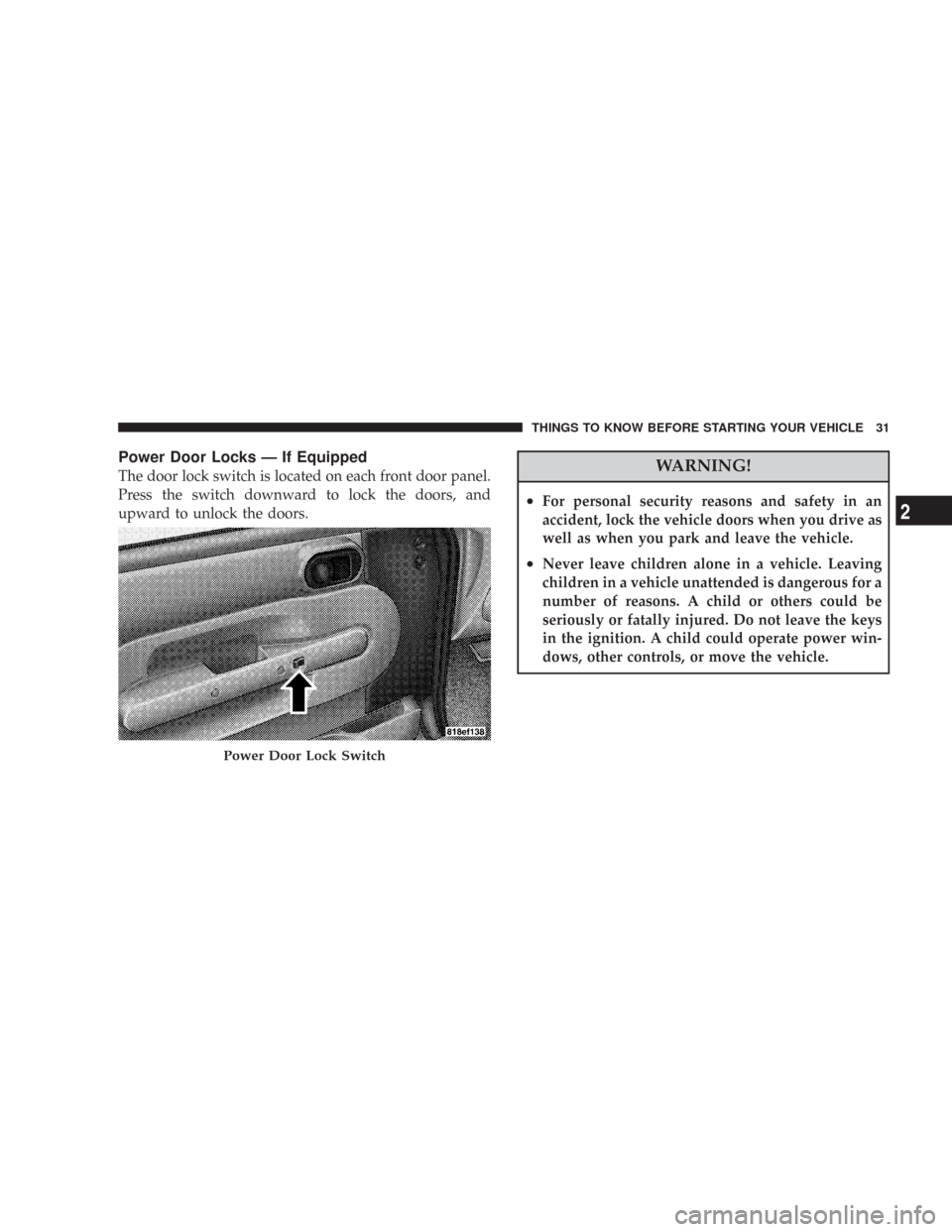
Power Door Locks — If Equipped
The door lock switch is located on each front door panel.
Press the switch downward to lock the doors, and
upward to unlock the doors.WARNING!
•For personal security reasons and safety in an
accident, lock the vehicle doors when you drive as
well as when you park and leave the vehicle.
•Never leave children alone in a vehicle. Leaving
children in a vehicle unattended is dangerous for a
number of reasons. A child or others could be
seriously or fatally injured. Do not leave the keys
in the ignition. A child could operate power win-
dows, other controls, or move the vehicle.
Power Door Lock Switch
THINGS TO KNOW BEFORE STARTING YOUR VEHICLE 31
2
Page 32 of 467
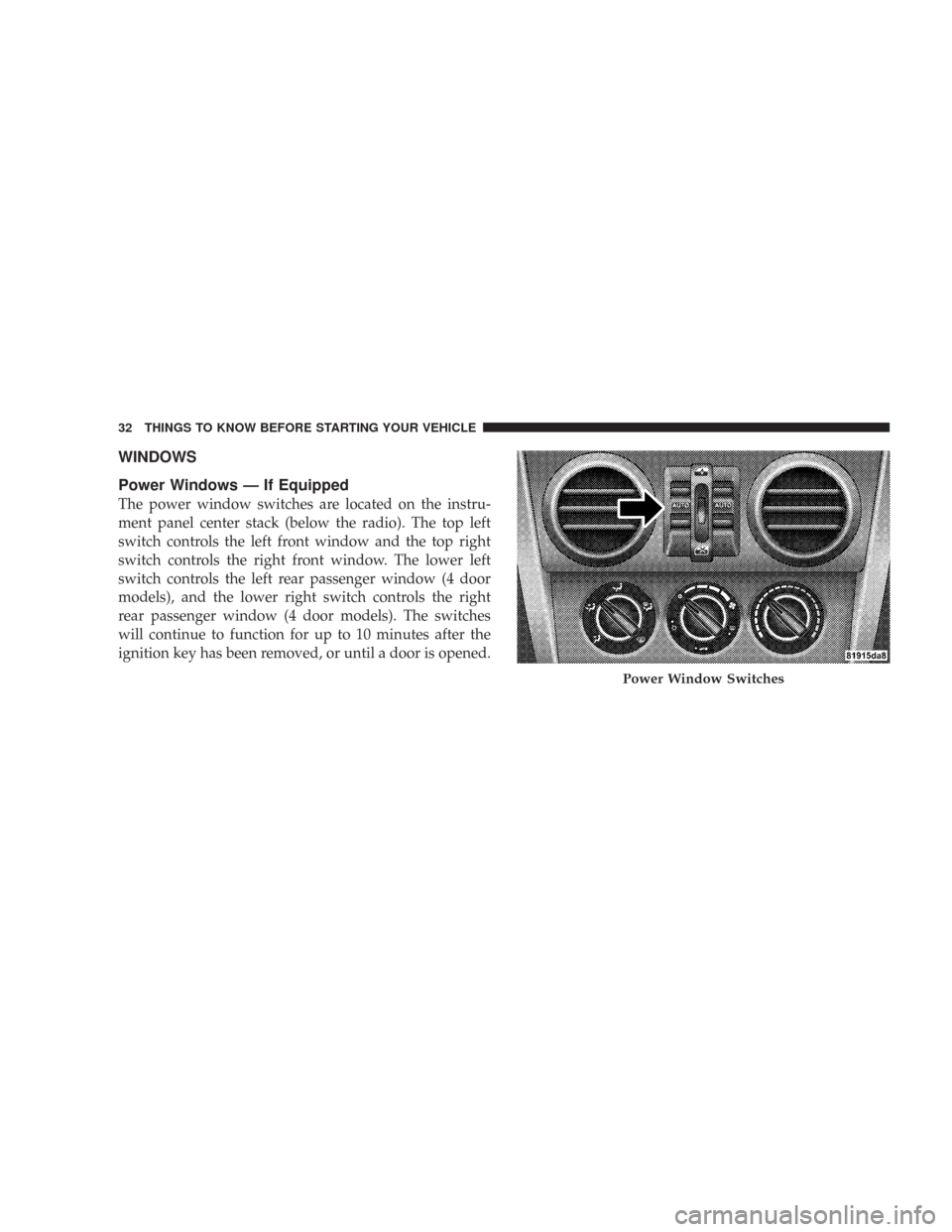
WINDOWS
Power Windows — If Equipped
The power window switches are located on the instru-
ment panel center stack (below the radio). The top left
switch controls the left front window and the top right
switch controls the right front window. The lower left
switch controls the left rear passenger window (4 door
models), and the lower right switch controls the right
rear passenger window (4 door models). The switches
will continue to function for up to 10 minutes after the
ignition key has been removed, or until a door is opened.
Power Window Switches
32 THINGS TO KNOW BEFORE STARTING YOUR VEHICLE
Page 33 of 467
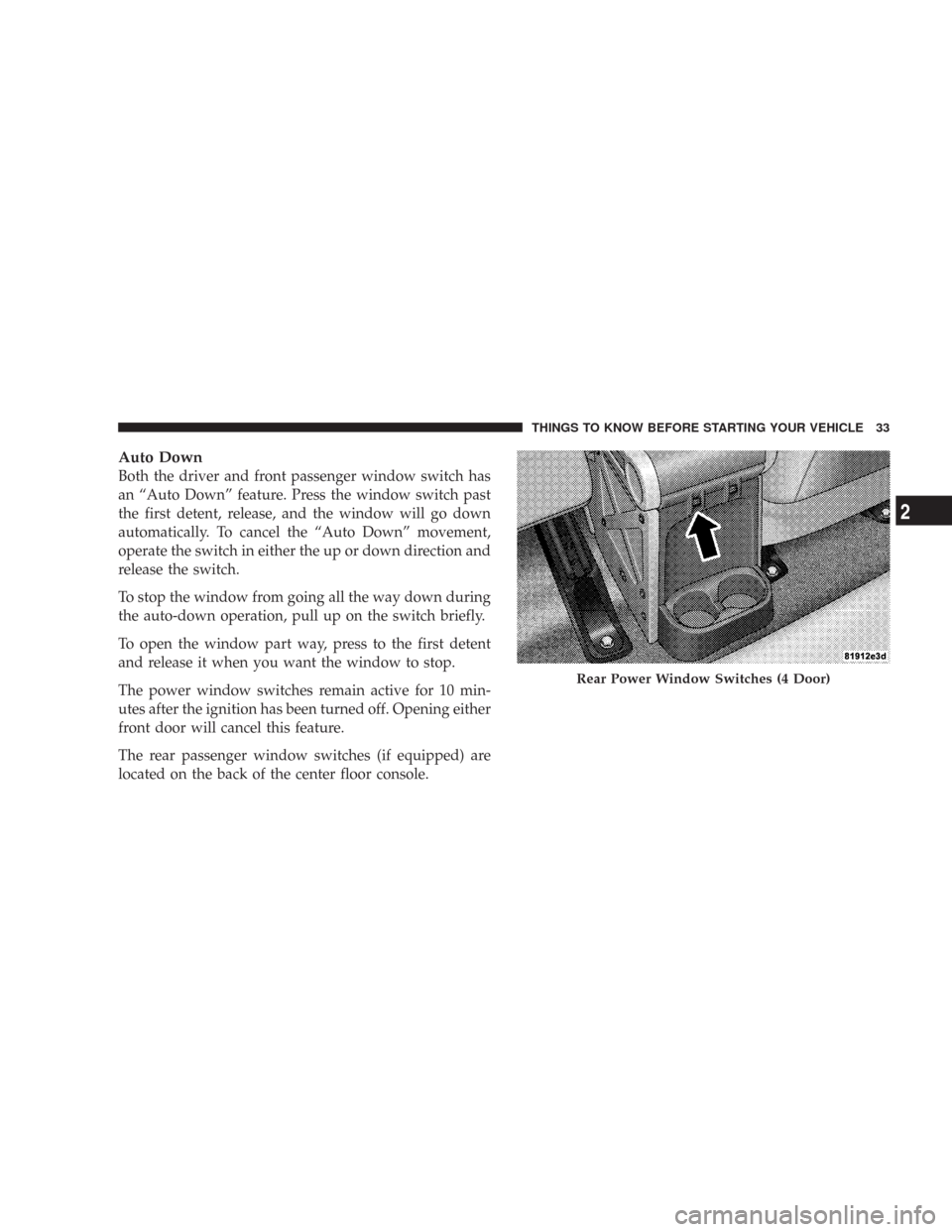
Auto Down
Both the driver and front passenger window switch has
an “Auto Down” feature. Press the window switch past
the first detent, release, and the window will go down
automatically. To cancel the “Auto Down” movement,
operate the switch in either the up or down direction and
release the switch.
To stop the window from going all the way down during
the auto-down operation, pull up on the switch briefly.
To open the window part way, press to the first detent
and release it when you want the window to stop.
The power window switches remain active for 10 min-
utes after the ignition has been turned off. Opening either
front door will cancel this feature.
The rear passenger window switches (if equipped) are
located on the back of the center floor console.
Rear Power Window Switches (4 Door)
THINGS TO KNOW BEFORE STARTING YOUR VEHICLE 33
2
Page 34 of 467
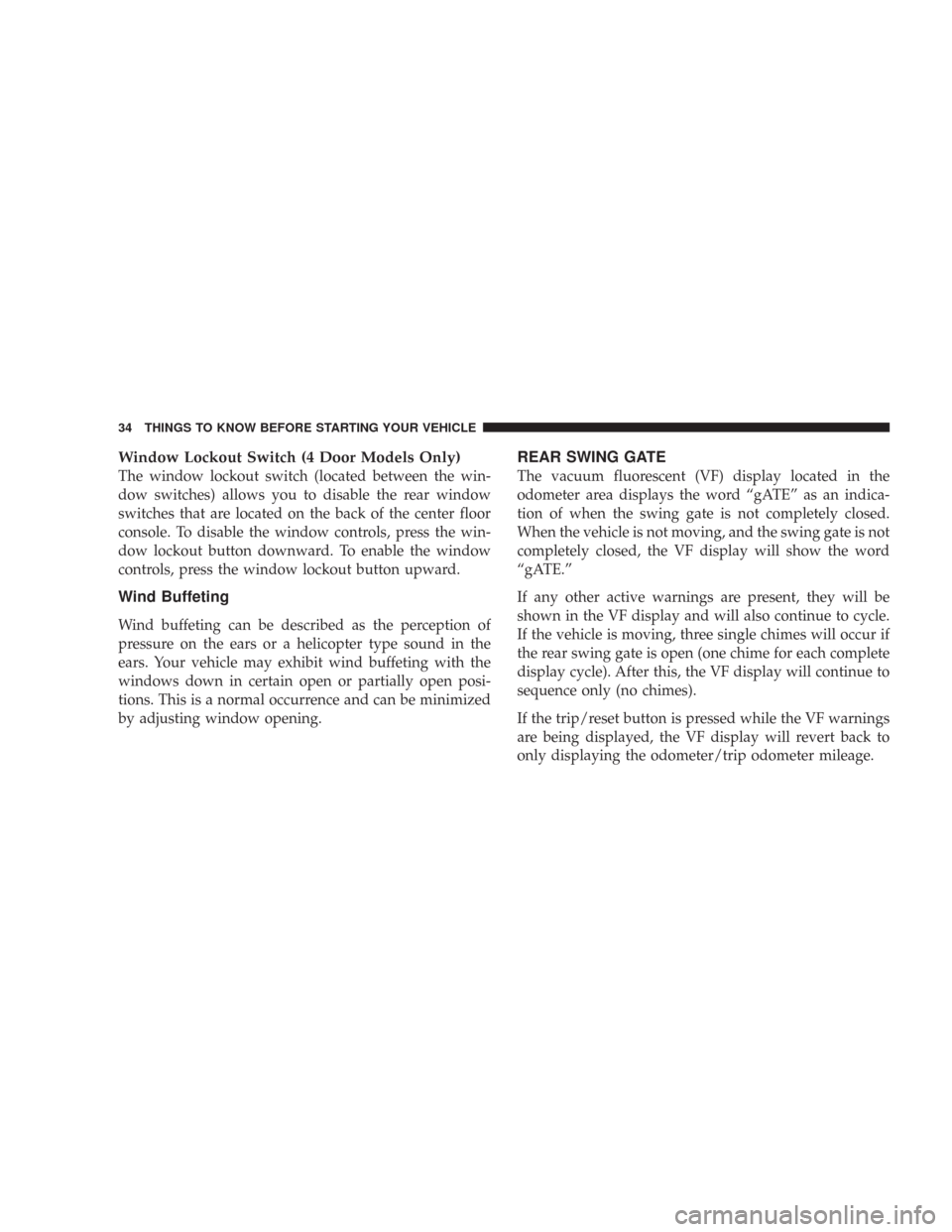
Window Lockout Switch (4 Door Models Only)
The window lockout switch (located between the win-
dow switches) allows you to disable the rear window
switches that are located on the back of the center floor
console. To disable the window controls, press the win-
dow lockout button downward. To enable the window
controls, press the window lockout button upward.
Wind Buffeting
Wind buffeting can be described as the perception of
pressure on the ears or a helicopter type sound in the
ears. Your vehicle may exhibit wind buffeting with the
windows down in certain open or partially open posi-
tions. This is a normal occurrence and can be minimized
by adjusting window opening.
REAR SWING GATE
The vacuum fluorescent (VF) display located in the
odometer area displays the word “gATE” as an indica-
tion of when the swing gate is not completely closed.
When the vehicle is not moving, and the swing gate is not
completely closed, the VF display will show the word
“gATE.”
If any other active warnings are present, they will be
shown in the VF display and will also continue to cycle.
If the vehicle is moving, three single chimes will occur if
the rear swing gate is open (one chime for each complete
display cycle). After this, the VF display will continue to
sequence only (no chimes).
If the trip/reset button is pressed while the VF warnings
are being displayed, the VF display will revert back to
only displaying the odometer/trip odometer mileage.
34 THINGS TO KNOW BEFORE STARTING YOUR VEHICLE
Page 35 of 467
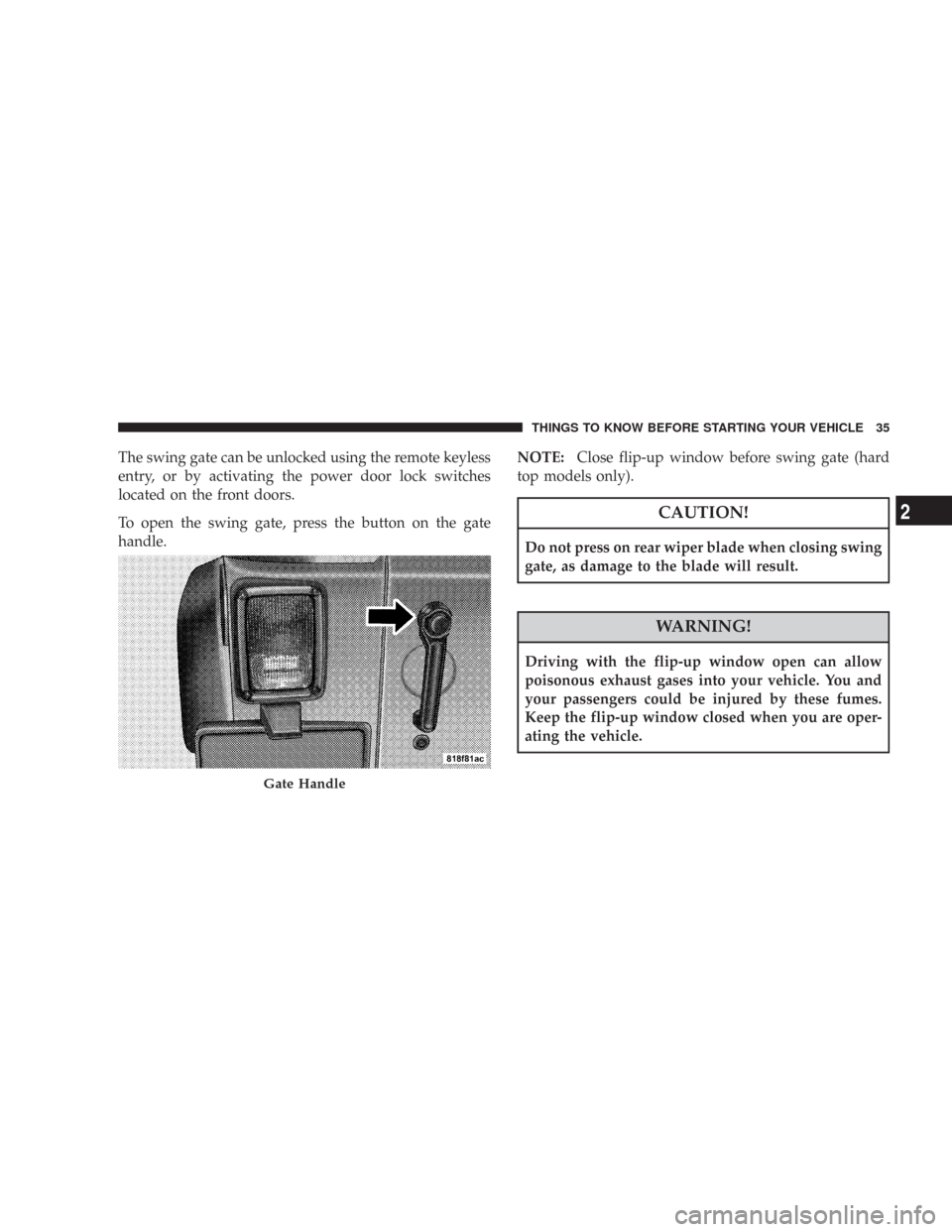
The swing gate can be unlocked using the remote keyless
entry, or by activating the power door lock switches
located on the front doors.
To open the swing gate, press the button on the gate
handle.NOTE:Close flip-up window before swing gate (hard
top models only).
CAUTION!
Do not press on rear wiper blade when closing swing
gate, as damage to the blade will result.
WARNING!
Driving with the flip-up window open can allow
poisonous exhaust gases into your vehicle. You and
your passengers could be injured by these fumes.
Keep the flip-up window closed when you are oper-
ating the vehicle.
Gate Handle
THINGS TO KNOW BEFORE STARTING YOUR VEHICLE 35
2
Page 36 of 467
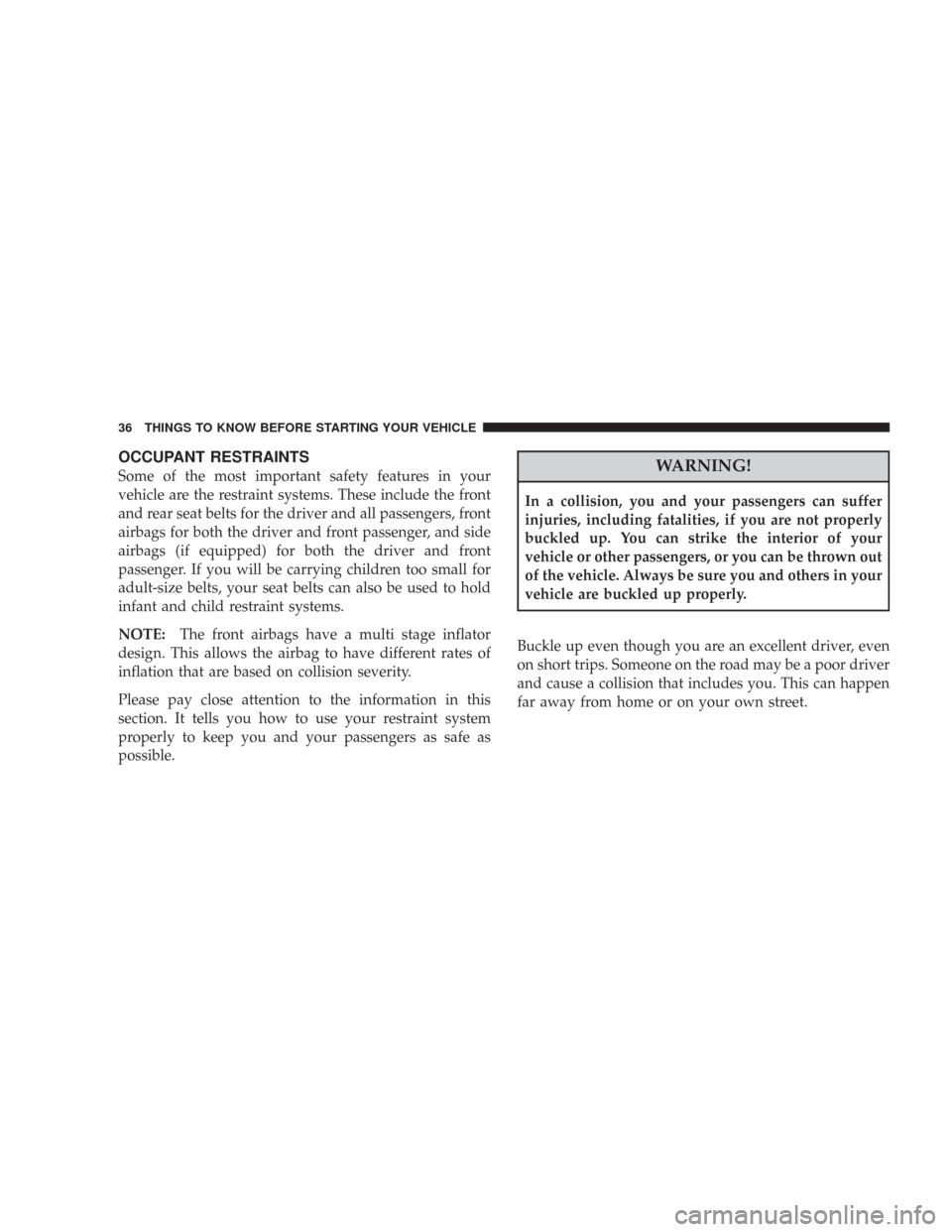
OCCUPANT RESTRAINTS
Some of the most important safety features in your
vehicle are the restraint systems. These include the front
and rear seat belts for the driver and all passengers, front
airbags for both the driver and front passenger, and side
airbags (if equipped) for both the driver and front
passenger. If you will be carrying children too small for
adult-size belts, your seat belts can also be used to hold
infant and child restraint systems.
NOTE:The front airbags have a multi stage inflator
design. This allows the airbag to have different rates of
inflation that are based on collision severity.
Please pay close attention to the information in this
section. It tells you how to use your restraint system
properly to keep you and your passengers as safe as
possible.WARNING!
In a collision, you and your passengers can suffer
injuries, including fatalities, if you are not properly
buckled up. You can strike the interior of your
vehicle or other passengers, or you can be thrown out
of the vehicle. Always be sure you and others in your
vehicle are buckled up properly.
Buckle up even though you are an excellent driver, even
on short trips. Someone on the road may be a poor driver
and cause a collision that includes you. This can happen
far away from home or on your own street.
36 THINGS TO KNOW BEFORE STARTING YOUR VEHICLE
Page 37 of 467
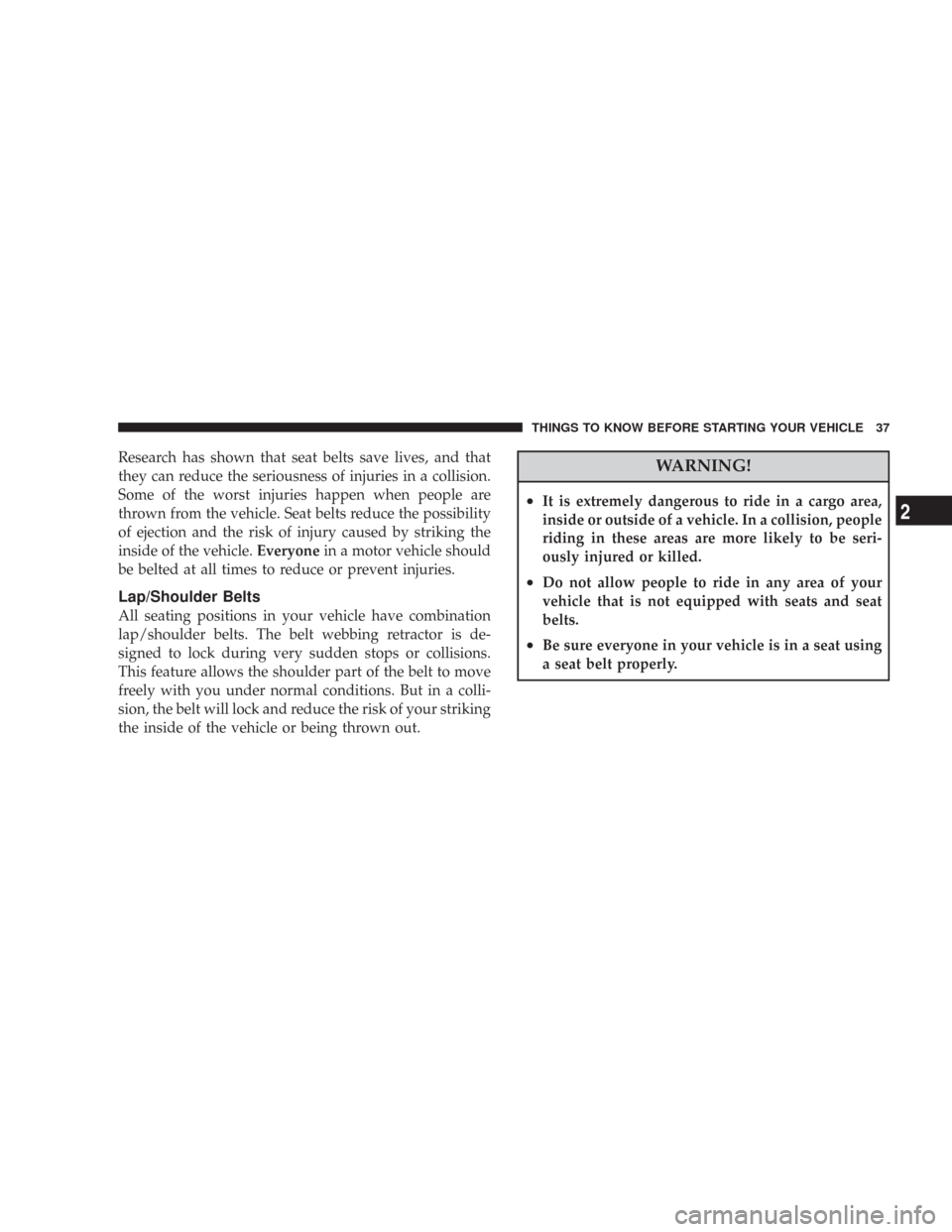
Research has shown that seat belts save lives, and that
they can reduce the seriousness of injuries in a collision.
Some of the worst injuries happen when people are
thrown from the vehicle. Seat belts reduce the possibility
of ejection and the risk of injury caused by striking the
inside of the vehicle.Everyonein a motor vehicle should
be belted at all times to reduce or prevent injuries.
Lap/Shoulder Belts
All seating positions in your vehicle have combination
lap/shoulder belts. The belt webbing retractor is de-
signed to lock during very sudden stops or collisions.
This feature allows the shoulder part of the belt to move
freely with you under normal conditions. But in a colli-
sion, the belt will lock and reduce the risk of your striking
the inside of the vehicle or being thrown out.
WARNING!
•It is extremely dangerous to ride in a cargo area,
inside or outside of a vehicle. In a collision, people
riding in these areas are more likely to be seri-
ously injured or killed.
•Do not allow people to ride in any area of your
vehicle that is not equipped with seats and seat
belts.
•Be sure everyone in your vehicle is in a seat using
a seat belt properly.
THINGS TO KNOW BEFORE STARTING YOUR VEHICLE 37
2
Page 38 of 467
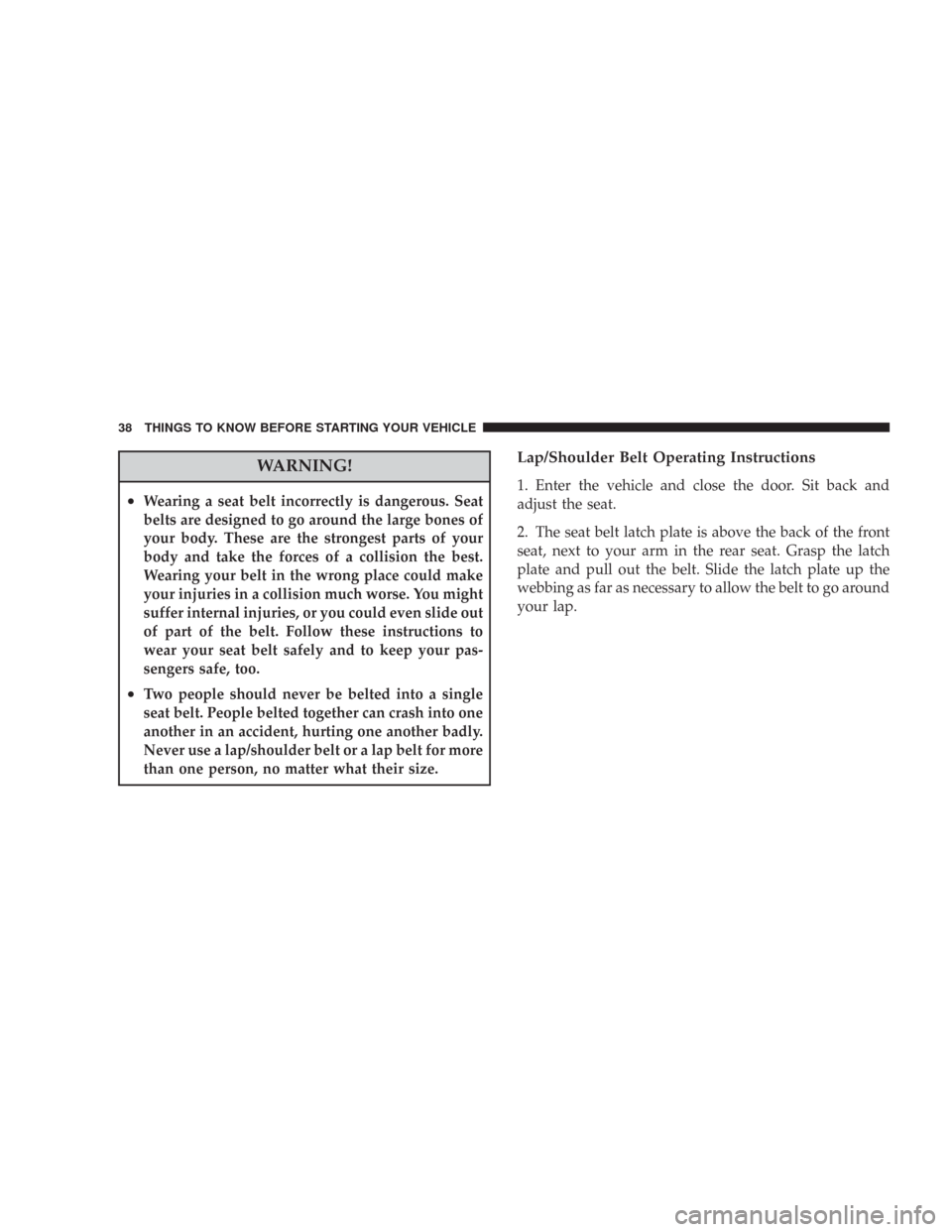
WARNING!
•Wearing a seat belt incorrectly is dangerous. Seat
belts are designed to go around the large bones of
your body. These are the strongest parts of your
body and take the forces of a collision the best.
Wearing your belt in the wrong place could make
your injuries in a collision much worse. You might
suffer internal injuries, or you could even slide out
of part of the belt. Follow these instructions to
wear your seat belt safely and to keep your pas-
sengers safe, too.
•Two people should never be belted into a single
seat belt. People belted together can crash into one
another in an accident, hurting one another badly.
Never use a lap/shoulder belt or a lap belt for more
than one person, no matter what their size.
Lap/Shoulder Belt Operating Instructions
1. Enter the vehicle and close the door. Sit back and
adjust the seat.
2. The seat belt latch plate is above the back of the front
seat, next to your arm in the rear seat. Grasp the latch
plate and pull out the belt. Slide the latch plate up the
webbing as far as necessary to allow the belt to go around
your lap.
38 THINGS TO KNOW BEFORE STARTING YOUR VEHICLE
Page 39 of 467
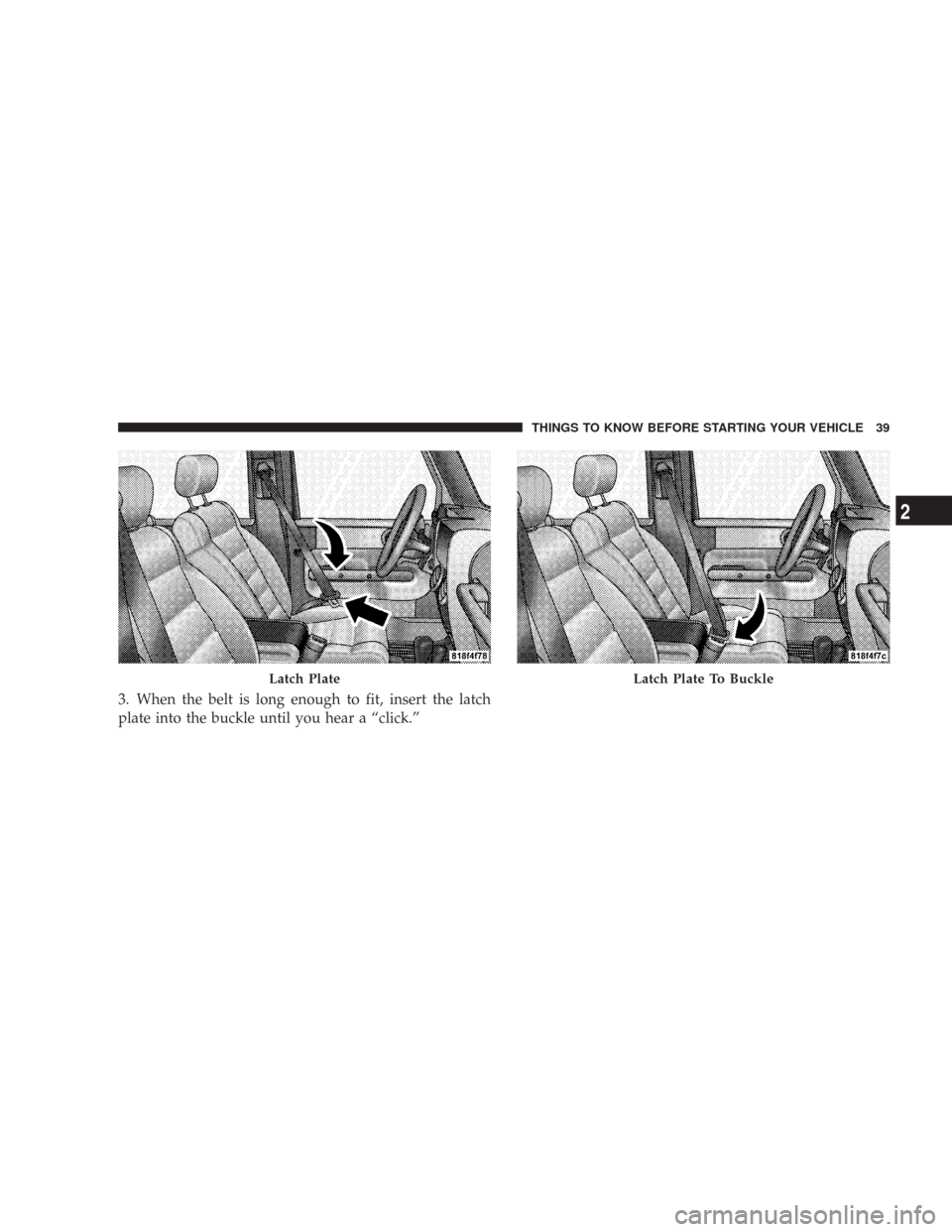
3. When the belt is long enough to fit, insert the latch
plate into the buckle until you hear a “click.”
Latch PlateLatch Plate To Buckle
THINGS TO KNOW BEFORE STARTING YOUR VEHICLE 39
2
Page 40 of 467
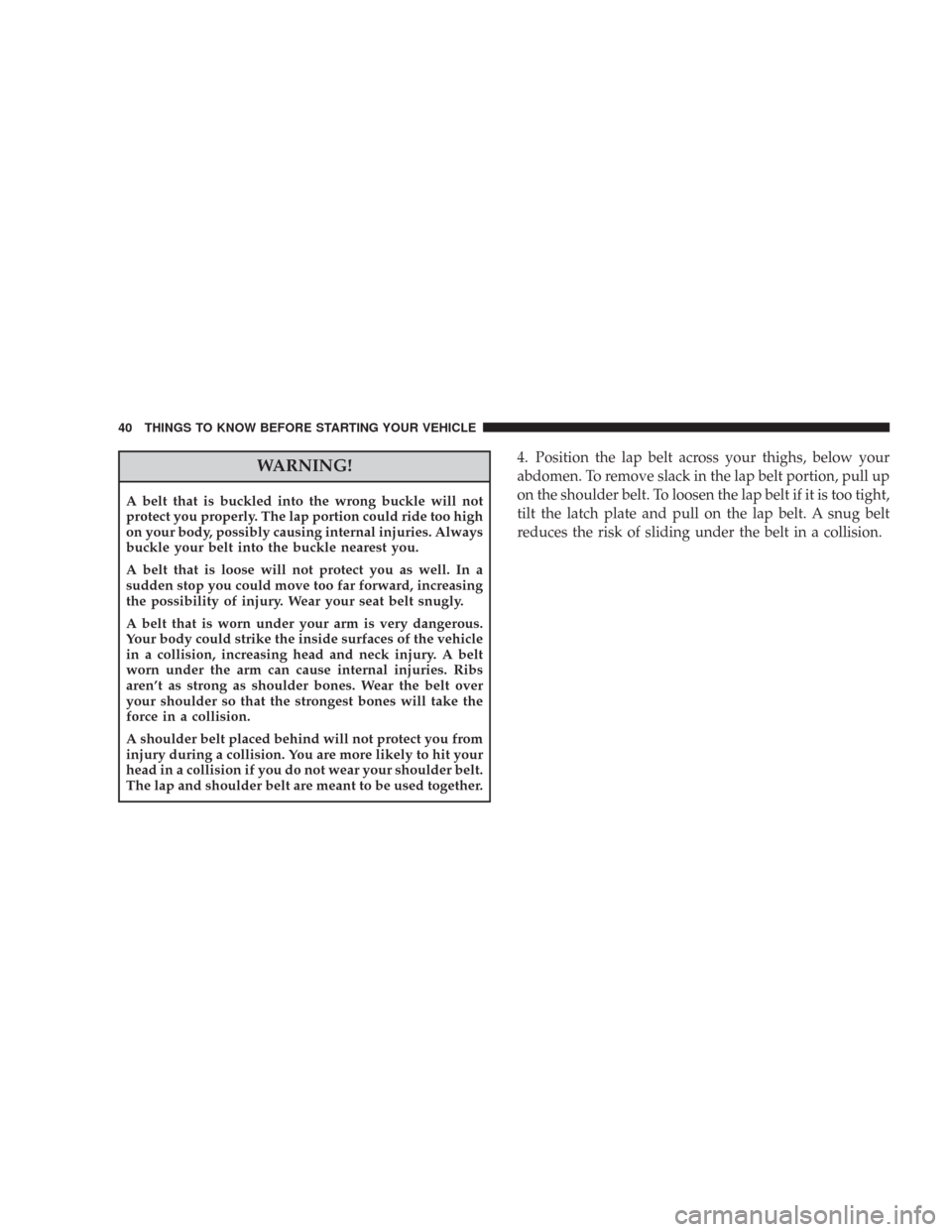
WARNING!
A belt that is buckled into the wrong buckle will not
protect you properly. The lap portion could ride too high
on your body, possibly causing internal injuries. Always
buckle your belt into the buckle nearest you.
A belt that is loose will not protect you as well. In a
sudden stop you could move too far forward, increasing
the possibility of injury. Wear your seat belt snugly.
A belt that is worn under your arm is very dangerous.
Your body could strike the inside surfaces of the vehicle
in a collision, increasing head and neck injury. A belt
worn under the arm can cause internal injuries. Ribs
aren’t as strong as shoulder bones. Wear the belt over
your shoulder so that the strongest bones will take the
force in a collision.
A shoulder belt placed behind will not protect you from
injury during a collision. You are more likely to hit your
head in a collision if you do not wear your shoulder belt.
The lap and shoulder belt are meant to be used together.
4. Position the lap belt across your thighs, below your
abdomen. To remove slack in the lap belt portion, pull up
on the shoulder belt. To loosen the lap belt if it is too tight,
tilt the latch plate and pull on the lap belt. A snug belt
reduces the risk of sliding under the belt in a collision.
40 THINGS TO KNOW BEFORE STARTING YOUR VEHICLE